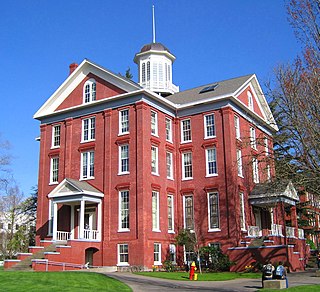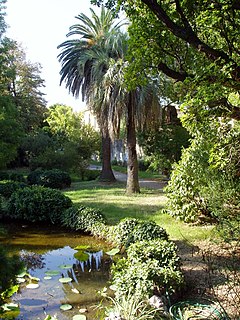
Wilsonville is a city primarily in Clackamas County, Oregon, United States. A portion of the northern section of the city is in Washington County. It was founded as Boones Landing because of the Boones Ferry which crossed the Willamette River at the location; the community became Wilsonville in 1880. The city was incorporated in 1969 with a population of approximately 1,000. The population was 13,991 at the 2000 census, and grew to 19,509 as of 2010. Slightly more than 90% of residents at the 2000 census were white, with Hispanics comprising the largest minority group.

The Willamette Falls is a natural waterfall on the Willamette River between Oregon City and West Linn, Oregon, in the United States. It is the largest waterfall in the Northwestern United States by volume, and the seventeenth widest in the world. Horseshoe in shape, it is 1,500 feet (460 m) wide and 40 feet (12 m) high with a flow of 30,849 cu ft/s, located 26 miles (42 km) upriver from the Willamette's mouth.
The Willamette University MBA (Atkinson) is the Masters in Business Administration (MBA) program at Willamette University in Salem, Oregon, United States. It is one of only two MBA programs in the world accredited for both Business Administration and Public Administration (NASPAA). Atkinson was established by Willamette in 1974 and has an enrollment of approximately 312 students.

The Oregon School for the Blind (OSB), was a state-run public school in Salem, Oregon, United States, serving blind and vision impaired students of kindergarten through high school grades through residential, day school, and part-time enrollment programs. Opened in 1873, the school was operated by the Oregon Department of Education. The school's closure in 2009 had been the culmination of several years of contentious debate that continued after the closure when lawsuits were filed concerning the sale of the campus.

Waller Hall is the oldest building on the campus of Willamette University in Salem, Oregon, United States. Built in 1867 as University Hall, the five-story, red-brick structure was added to the National Register of Historic Places in 1975. The building has been gutted twice by fires with the interior rebuilt each time, and went through renovations in 1987 to 1989 and again in 2005.

The Mark O. Hatfield Library is the main library at Willamette University in Salem, Oregon, United States. Opened in 1986, it is a member of the Orbis Cascade Alliance along with several library lending networks, and is a designated Federal depository library. Willamette's original library was established in 1844, two years after the school was founded. The library was housed in Waller Hall before moving to its own building in 1938.

The Hallie Ford Museum of Art (HFMA) is the museum of Willamette University in Salem, Oregon, United States. It is the third largest art museum in Oregon. Opened in 1998, the facility is across the street from the Oregon State Capital in downtown Salem, on the western edge of the school campus. Hallie Ford exhibits collections of both art and historical artifacts with a focus on Oregon related pieces of art and artists in the 27,000 square feet (2,500 m2) facility. The museum also hosts various traveling exhibits in two of its six galleries.

Eaton Hall is an academic building on the campus of Willamette University in Salem, Oregon, United States. Completed in 1909, the four-story brick and stone hall is the fourth oldest building on the campus of the school after Waller Hall (1867), Gatke Hall (1903), and the Art Building (1907). Eaton is a mix of architectural styles and houses the humanities departments of the liberal arts college.

The Collegian or Willamette Collegian is the student-run newspaper of Willamette University in Salem, Oregon, United States. Founded in 1875, the weekly paper has been in continuous publication since 1889. It is a member of the College Publisher Network.

Willamette Mission State Park is a state park in the U.S. state of Oregon, located about four miles (6 km) north of Keizer adjacent to the Wheatland Ferry and east of the Willamette River. It includes Willamette Station Site, Methodist Mission in Oregon, which is listed by the National Register of Historic Places.

Coffee Creek Correctional Facility is a women's prison and prisoner intake center in Wilsonville, Oregon, United States. Operated by the Oregon Department of Corrections, the 1,684-bed facility opened in 2001 at a 108-acre (0.44 km2) campus. The selection of the location for the prison was controversial and included legal challenges. The minimum and medium security facility operates several programs designed to teach skills to inmates. Coffee Creek is the only women's prison in Oregon.

Erratic Rock State Natural Site is a state park in the Willamette Valley of Oregon, United States. Featuring a 40-short-ton (36 t) glacial erratic from the Missoula Floods, the small park sits atop a foothill of the Northern Oregon Coast Range in Yamhill County between Sheridan and McMinnville off Oregon Route 18. The day use only park is owned and maintained by the Oregon Parks and Recreation Department.

The Oregon Civic Justice Center is a three-story former library building on the campus of Willamette University in downtown Salem, Oregon, United States. Built in 1912 as a Carnegie library for the city of Salem, the building now houses several programs of Willamette University College of Law. Prior to the law school's moving into the facility in 2008, the building was used by the adjacent Young Women's Christian Association (YWCA) from 1971 to 2006.

The Pacific University Health Professions Campus is a satellite campus of Pacific University located in downtown Hillsboro, Oregon, United States. Opened in 2006, the campus contains the school's College of Health Professions with plans to move Pacific's College of Optometry and School of Professional Psychology in later phases. Housed in two brick buildings, the campus is located in the city's Health and Education District and adjacent to the Tuality Hospital/Southeast 8th Avenue light rail station. The campus of Tuality Community Hospital is across Baseline Street to the south.

The Willamette Bearcats are the athletic teams of Willamette University in Salem, Oregon, United States. Competing at the non-scholarship National Collegiate Athletic Association (NCAA) Division III level, the school fields twenty teams. Most teams compete in the Northwest Conference with their primary rivals being Linfield College. The main athletic venues of the school are McCulloch Stadium, Cone Field House, and Roy S. "Spec" Keene Stadium. Willamette moved to the NCAA's Division III in 1998 after previously being a National Association of Intercollegiate Athletics (NAIA) institution. The 1993, men's basketball team won the school's only team national championship, while the 1997 football team lost in the national championship game.

Rood Bridge Park is a municipal park in southeast Hillsboro, Oregon, United States. Opened in 1999, the park encompasses 60 acres (24 ha) on the north bank of the Tualatin River at its confluence with Rock Creek. Rood Bridge is near Hillsboro High School and sits across the river from Meriwether National Golf Course. The park is the city’s largest, and contains tennis courts, a meeting facility, trails, a canoe launch, and a rhododendron garden among other features.

Lausanne Hall is a college residence hall at Willamette University in Salem, Oregon, United States. Built in 1920, the red-brick and stone-accented structure stands three stories tall along Winter Street on the western edge of the campus that was originally a residence for women only. The late Gothic Revival style building replaced a home that had also been used as a dormitory. This structure was moved to campus and originally was named as the Women's College before assuming the name of Lausanne.

Ford Hall is a four-story academic hall at Willamette University in Salem in the U.S. state of Oregon. Completed in 2009, the building houses classrooms, offices, and laboratories from several disciplines of the school's College of Liberal Arts. The 42,000-square-foot (3,900 m2) structure cost $16 million and earned Leadership in Energy and Environmental Design (LEED) Gold certification upon completion for environmentally friendly features and construction. Ford Hall is named in honor of Hallie Ford, who contributed $8 million towards construction of the building.

























